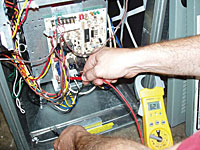It is difficult to eliminate all mistakes; however, it is possible to minimize the number of mistakes made and eliminate making some of the relatively common ones.
Mistakes may occur for many reasons. If technicians are given too many calls to handle in a day, they may rush, taking shortcuts in order to complete their calls faster. Mistakes also may occur if a technician is distracted due to any number of personal or work-related problems. Distractions can cause a technician not to pay attention to the job he is on and this may lead to mistakes. Technicians can also make mistakes if they become lazy and do not take the necessary steps to correctly diagnose and repair a system.
10 COMMON MISTAKES
Here are some common mistakes every technician should avoid.1. Not checking for a refrigerant leak at a service port after removing service gauges.
Many times valve stems or the valve itself will leak. This may go unnoticed and refrigerant can leak out of the system.
It is good practice to always replace the caps on any service port removed during the service call. If the valve is leaking, the cap might be enough to correct the leak. If left uncapped, the port could rust over, and the next technician on the job might not to be able to install service gauges.
2. Not checking the condition of the evaporator coil.
By examining the condition of the evaporator, many times a service technician can tell if the coil is fully active, iced over, or starved for refrigerant. This can help him find the source of the problem.
For example, if a technician is troubleshooting a system and finds a low suction pressure reading, he may assume that the system is low on charge.
However, if he were to check the condition of the evaporator, he would see that the coil was iced over, causing the low suction pressure. If the technician assumes the system is low on charge and adds refrigerant, not only will he not solve the problem, but also he most likely will cause another problem.
3. Relying only on reading the suction pressure of a system and ignoring the discharge pressure.
This shortcut can surely lead to misdiagnosing a system. Abnormal suction pressure can be caused by several different problems. The suction pressure alone will not indicate the exact cause of a problem - the tech must look at both the suction and discharge pressures.
It's not always easy to read the discharge pressure. The smaller a system, the fewer access valves it has. Many times there are no access valves on the system's high side, and a technician must add a valve to be able to read the discharge pressure. If this step is omitted, the tech may assume something incorrect about the discharge pressure.
For example, if a technician relies only on reading the suction pressure on a cap tube system and notices it is low, he may conclude that the system's charge is low. However, a restricted capillary tube could also cause a low suction pressure. Without also reading the discharge pressure, a technician cannot make an accurate diagnosis.
4. Not waiting for a system to cycle off on its temperature control.
Many times before a technician arrives on a job, a customer will try to resolve the problem by adjusting the thermometer, usually to a colder temperature. If a tech doesn't look for this, he may have to return after the customer calls complaining that the case is too cold. Although waiting for the system to cycle off might seem time consuming, it's better than having to go back out.

After converting a system to a new refrigerant, it's important to mark that system information. This will let the next technician on the job know that the refrigerant has been changed over and what the new type is.
If the new refrigerant is not marked on the equipment, the next technician may not know that the refrigerant has been converted, and this could lead to problems if he needs to add refrigerant. If he unknowingly adds the wrong refrigerant, the entire charge will need to be removed and the system recharged with the correct refrigerant.
6. Being too aggressive when de-icing an evaporator coil.
Technicians are commonly called due to an iced-up evaporator. As part of the repair process, the coil will need to be de-iced. Being too aggressive when defrosting the coil, however, could easily create a leak. Never use an ice pick or metal object to de-ice a coil. The best way to de-ice a coil is with water; however this is messy and not always practical. A heat gun also works well, but take care not to overheat any items close to the evaporator.
7. Choosing the wrong rotation on a replacement motor.
Determining if a motor is defective is normally an easy process; replacing the motor, however, is sometimes tricky. If the exact OEM part isn't available, a technician can usually match up a universal motor that will work.
A technician must consider many specifications to choose the right motor. One that could cause a technician to make a mistake is the rotation; the tech needs to match the replacement motor's rotation to the original motor's.
Manufacturers state the rotation of their motors one of two ways: on the motor facing the shaft end or facing the lead end.
The information is abbreviated. For instance, CWLE stands for "clock-wise lead end." Sometimes the motor will only state its rotation (CW for clock-wise). The technician must determine if the stated rotation is lead end or shaft end.
8. Not checking the voltage of a replacement component before installing it.
When changing out a component, a technician must verify the replacement component is the right voltage. Sometimes technicians are given components with the wrong voltage at a supply house, or they pick up the wrong component at the shop. This mistake can be costly, especially when installing a replacement compressor.
Installing the wrong compressor is not easy to rectify. The service technician will most likely need to remove the incorrect re- placement and install the correct one, which will require extra time and material, and for which he will not get paid.
9. Not verifying that the power is off when working with electrical components.
This mistake could cause serious injury to a technician as well as to the equipment. A quick test with a voltage stick can verify that the power is truly off. Do not assume the power is off even if the disconnect switch is off. A disconnect switch can fail, or may have been bypassed at an earlier time.
10. Damaging the threads of a bolt, nut, or flare nut.
Working with older equipment involves working with older nuts, bolts, and flare nuts. When taking these items off and putting them back on, take care not to force them - this could easily damage the threads.
If the threads don't easily fit on by hand, find out why before taking a wrench to them. Once the threads are damaged the piece will need to be replaced.
This is especially important when working with the bolts on a compressor. If these bolts become damaged, the technician may be forced to change out the whole compressor to fix the problem.
Expecting a technician never to make a mistake is not realistic. But with a little extra caution and common sense, every technician can easily avoid common mistakes and work to avoid making others.
Joe Marchese is owner of Coldtronics of Pittsburgh. He can be reached at 412-734-4433, www.coldtronics.com, or joe@coldtronics.com.
Publication date: 01/09/2006




